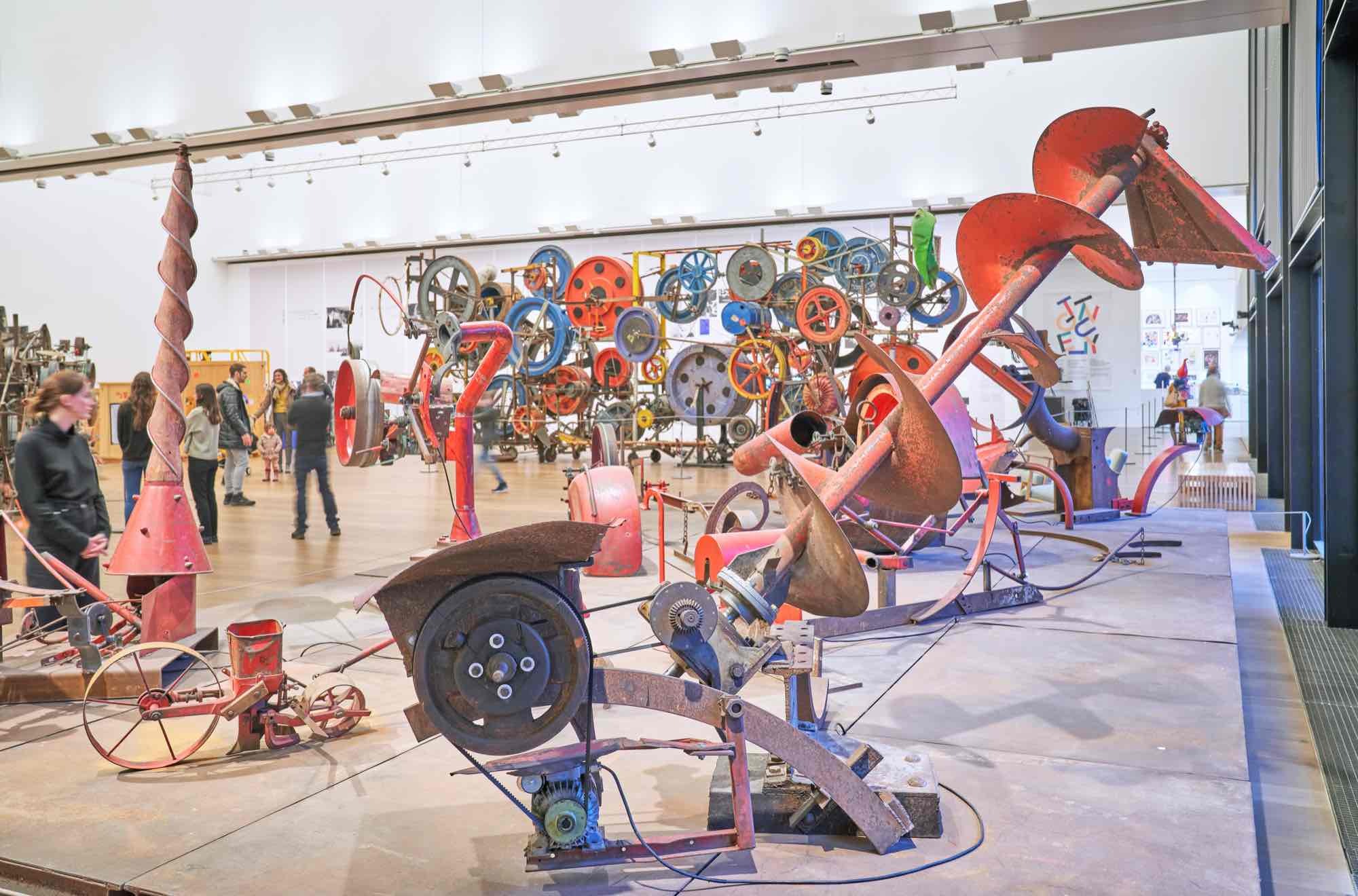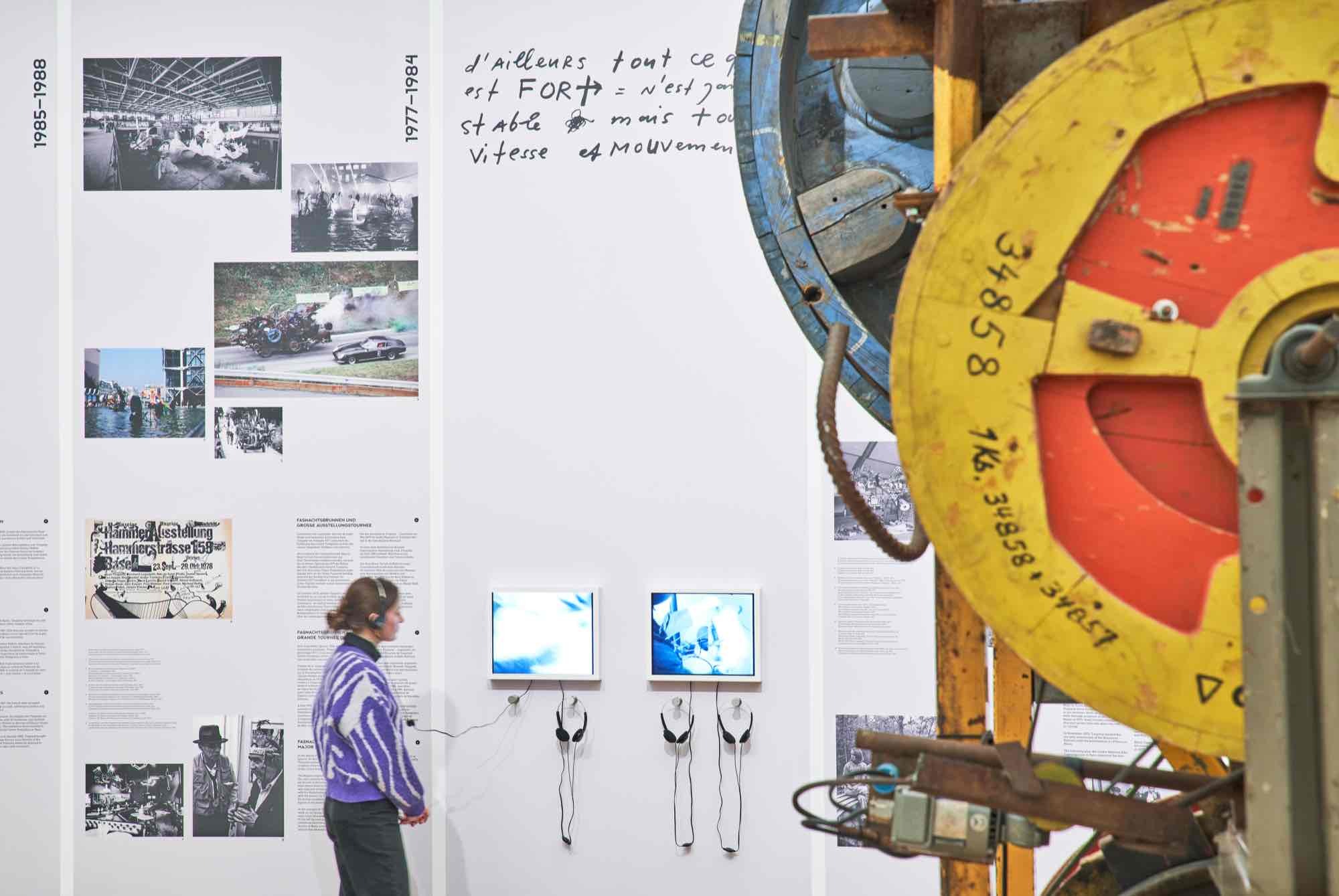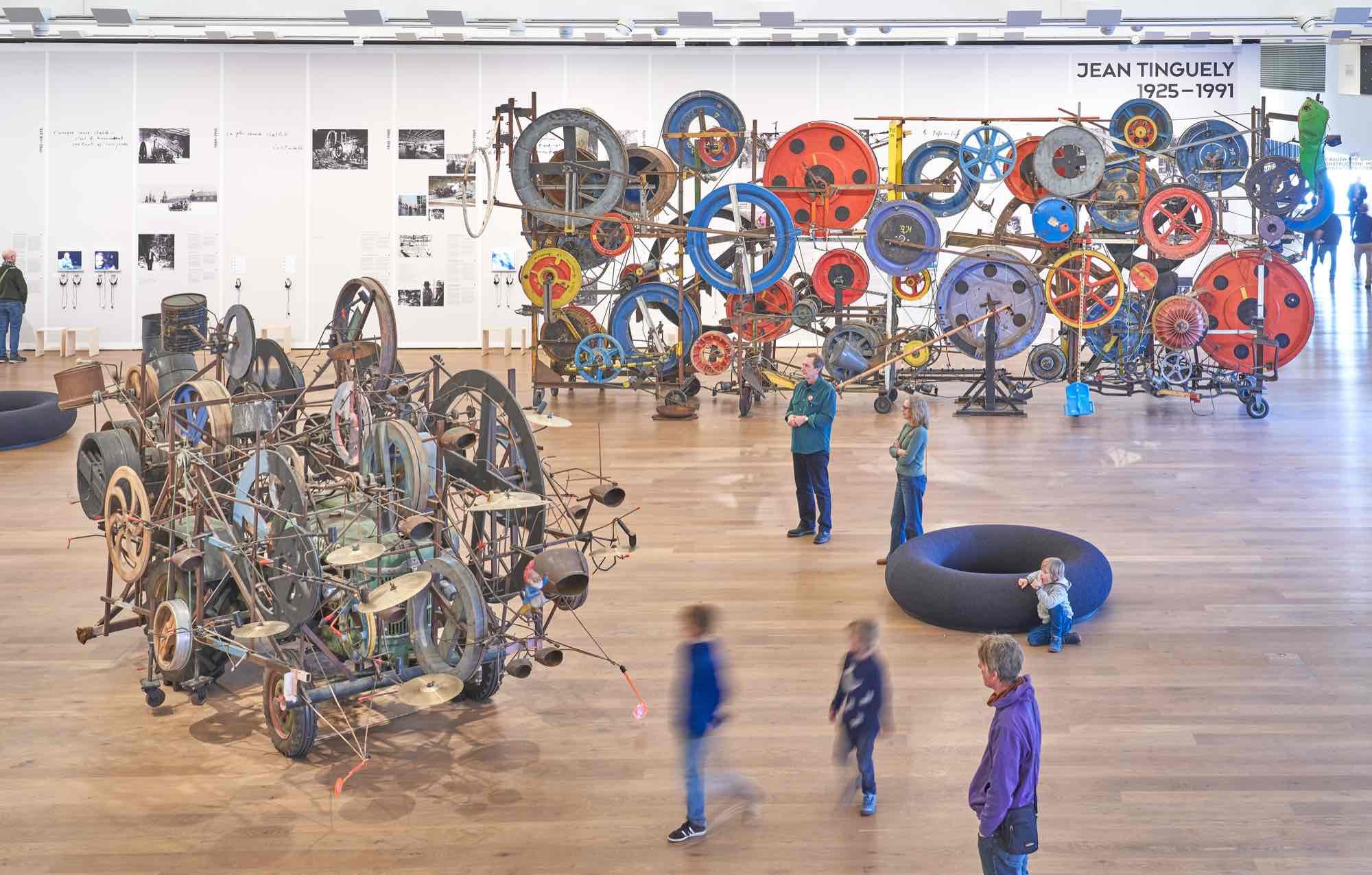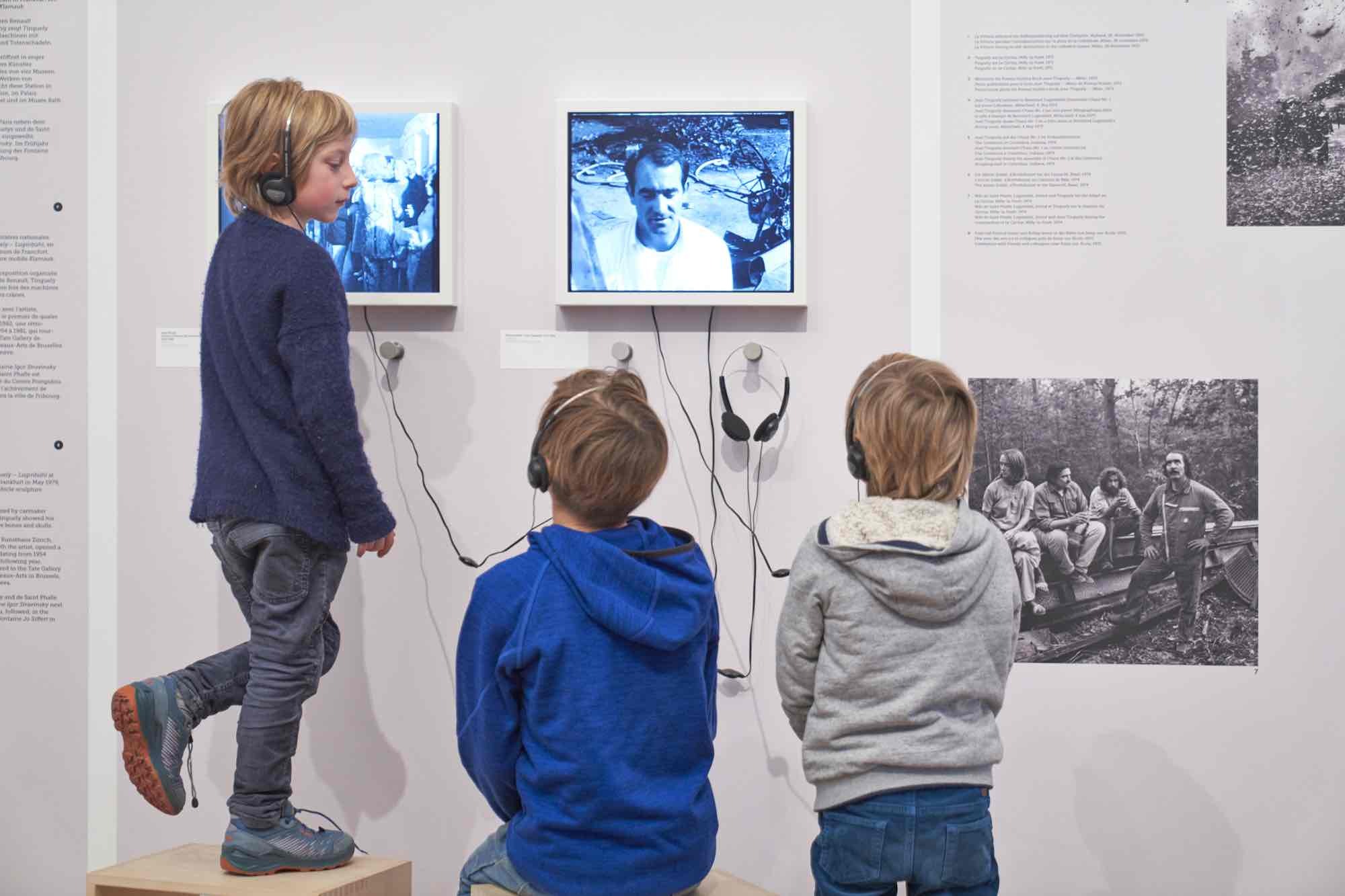La Roue = c’est tout
New presentation of Museum Tinguely’s collection
07 Feb 2023 - 01 Feb 2025

Jean Tinguelv. Eloge de la folie. 1966
Aluminum trame with wooden wheels, wire, rubber bands, balls, electric
motors, all painted black 540 × 780 × 75 cm
Installation view at Museum Tinguely
© Museum Tinguely, Basel; photo: Daniel Spehr
Aluminum trame with wooden wheels, wire, rubber bands, balls, electric
motors, all painted black 540 × 780 × 75 cm
Installation view at Museum Tinguely
© Museum Tinguely, Basel; photo: Daniel Spehr

Installation view of the exhibition La roue = c'est tout with early works by Jean Tinquely from the 1950s
Jean Tinguely, Méta-Matic No. 10, 1959 (in the front)
Jean Tinguely, Méta-Matic No. 14, 1959 (left, bottom)
Jean Tinguely, Variation pour spirale, 1959, (top, left)
Jean Tinguely, Translation No 1 - pour un triangle, 1958, (top, 2. from left)
Jean Tinguely, Variation, 1958, (top, 2. from right)
Jean Tinguely, Machine à dessiner No. 3, 1955, (top, right)
© Museum Tinguely, Basel; photo: Daniel Spehr
Jean Tinguely, Méta-Matic No. 10, 1959 (in the front)
Jean Tinguely, Méta-Matic No. 14, 1959 (left, bottom)
Jean Tinguely, Variation pour spirale, 1959, (top, left)
Jean Tinguely, Translation No 1 - pour un triangle, 1958, (top, 2. from left)
Jean Tinguely, Variation, 1958, (top, 2. from right)
Jean Tinguely, Machine à dessiner No. 3, 1955, (top, right)
© Museum Tinguely, Basel; photo: Daniel Spehr

Jean Tinguely, Ballet des pauvres, 1961
Aluminium plate, iron wheels, transmissions and rods, fabric, plastic, metal, furs, leather and other materials, electric motor
400 × 350 × 220 cm
Installation view at Museum Tinguely
© Museum Tinguely, Basel; photo: Daniel Spehr
Aluminium plate, iron wheels, transmissions and rods, fabric, plastic, metal, furs, leather and other materials, electric motor
400 × 350 × 220 cm
Installation view at Museum Tinguely
© Museum Tinguely, Basel; photo: Daniel Spehr

Jean Tinguely, Plateau agriculturel, 1978
Parts of agricultural machines (red), scrap iron, garden gnome, electric motor. 20 iron pedestals
Plateau 50 x 850 x 460. H 200 cm
Museum linguely, basel, Donaton Michenne und claude renard
Installation view at Museum Tinguely
© Museum Tinguely, Basel; photo: Christian Baur
Parts of agricultural machines (red), scrap iron, garden gnome, electric motor. 20 iron pedestals
Plateau 50 x 850 x 460. H 200 cm
Museum linguely, basel, Donaton Michenne und claude renard
Installation view at Museum Tinguely
© Museum Tinguely, Basel; photo: Christian Baur

Jean Tinguely, Plateau agriculturel, 1978 (detail, in the front)
Parts of agricultural machines (red), scrap iron, garden gnome, electric motor, 20 iron pedestals
Plateau 50 x 850 x 460. H 200 cm
Jean Tinguely, Fatamorgana, Méta- Harmonie IV, 1985 (in the background)
Installation view at Museum Tinguely
© Museum Tinguely, Basel; photo: Daniel Spehr
Parts of agricultural machines (red), scrap iron, garden gnome, electric motor, 20 iron pedestals
Plateau 50 x 850 x 460. H 200 cm
Jean Tinguely, Fatamorgana, Méta- Harmonie IV, 1985 (in the background)
Installation view at Museum Tinguely
© Museum Tinguely, Basel; photo: Daniel Spehr

Jean Tinguely, Fatamorgana, Méta-Harmonie IV, 1985 (detail, right)
Tron frame. wooden wheels. plastic parts. percussion instruments. light
bulbs, electric motors
420 × 1250 × 220 cm
Installation view at Museum Tinguely
© Museum Tinguely, Basel, photo. Danier Spehr
Tron frame. wooden wheels. plastic parts. percussion instruments. light
bulbs, electric motors
420 × 1250 × 220 cm
Installation view at Museum Tinguely
© Museum Tinguely, Basel, photo. Danier Spehr

Installation view of the exnibition La roue = c'est tour with works trom Jean Tinquely
Jean Tinguely, Fatamorgana, Méta-Harmonie IV, 1985 (in the background)
Iron frame, wooden wheels, plastic parts, percussion instruments, light bulbs, electric motors
420 × 1250 × 220 cm Jean Tinguely, Klamauk, 1979 (in front)
© Museum Tinguely, Basel; photo: Daniel Spehr
Jean Tinguely, Fatamorgana, Méta-Harmonie IV, 1985 (in the background)
Iron frame, wooden wheels, plastic parts, percussion instruments, light bulbs, electric motors
420 × 1250 × 220 cm Jean Tinguely, Klamauk, 1979 (in front)
© Museum Tinguely, Basel; photo: Daniel Spehr

Installation view of the exnibition La roue = c'est tour with works trom Jean Tinquely
Jean Tinguely, Fatamorgana, Méta-Harmonie IV, 1985 (in the background)
Iron frame, wooden wheels, plastic parts, percussion instruments, light bulbs, electric motors
420 × 1250 × 220 cm Jean Tinguely, Klamauk, 1979 (in front)
© Museum Tinguely, Basel; photo: Daniel Spehr
Jean Tinguely, Fatamorgana, Méta-Harmonie IV, 1985 (in the background)
Iron frame, wooden wheels, plastic parts, percussion instruments, light bulbs, electric motors
420 × 1250 × 220 cm Jean Tinguely, Klamauk, 1979 (in front)
© Museum Tinguely, Basel; photo: Daniel Spehr

Installation view or the exhibition La roue = c'est tout with works from Jean Tinquely
Jean Tinguely, Grosse Méta-Maxi-Maxi-Utopia, Méta-Harmonie, 1987 (in
me background)
Scrap iron. wooden wheels. aluminium steps. curtain. carousel horse pottery vase by Ursi Luginbunt, plastic flowers, garden gnome, electric
730 × 1700 × 700 cm
Museum Tinguely, Basel, Donation Niki de Saint Phalle Jean Tinguely, Klamauk, 1979 (in the front)
© Museum Tinguely, Basel; photo: Daniel Spehr
Jean Tinguely, Grosse Méta-Maxi-Maxi-Utopia, Méta-Harmonie, 1987 (in
me background)
Scrap iron. wooden wheels. aluminium steps. curtain. carousel horse pottery vase by Ursi Luginbunt, plastic flowers, garden gnome, electric
730 × 1700 × 700 cm
Museum Tinguely, Basel, Donation Niki de Saint Phalle Jean Tinguely, Klamauk, 1979 (in the front)
© Museum Tinguely, Basel; photo: Daniel Spehr

Installation view of the exhibition La roue = c'est tout
© Museum Tinguely, Basel; photo: Daniel Spehr
© Museum Tinguely, Basel; photo: Daniel Spehr
According to Tinguely, 'we live in a wheeled civilisation'. Even today, our lives are shaped largely by the relationship between man and machine and the resulting dependencies that Tinguely deconstructed with such relish. Now, for the first time since the museum was founded, its enlarged collection of Tinguely’s own works is to return to the great hall. There visitors will be able to discover the intricate and poetic early works, the explosive happenings and collaborations of the 1960s, and the musical, monumental and sombre works of Tinguely’s late period, all presented in an entertaining and eventful tour with many opportunities for hands-on participation.
For the first time since the Museum’s founding in 1996, a new permanent exhibition has been created on the basis of its own ever-growing collection. Supplemented by loans of key works, it offers a comprehensive overview of Tinguely’s oeuvre that takes his claim «La roue = c’est tout» as its leitmotif: as well as being a recurring theme throughout his career, the wheel also stands for his belief that changing times should find expression in art.
In 1952, having trained at the Academy of Applied Arts and worked as a window dresser in Basel, Tinguely moved to Paris, a bold step that would prove decisive for his career, giving access to new sources of inspiration and important contacts in the art world. The first section of the new exhibition highlights Tinguely’s inventiveness and innovativeness, showcasing the wire sculptures and reliefs from the 1950s that established his reputation as a pioneer of kinetic art. His breakthrough came in 1959 with the Méta-Matic drawing machines. By involving the audience, he questioned not only conventional definitions of artwork and artist, but also the structures of the capitalist art market.
In 1960, Tinguely joined other artists in the Nouveaux Réalistes, a movement dedicated to overcoming the divide between art and life. At the same time, Tinguely began making works out of scrap metal and everyday materials. In the permanent exhibition, these works are juxtaposed with the following series of black sculptures he made from the mid-1960s. By painting the sculptures black, Tinguely shifted the focus from the individual elements making up the machines to the different types of movement inscribed into them, ranging from light and elegant to heavy and pounding.
The new permanent exhibition also focuses attention on Tinguely’s performances and happenings, and on the joint projects he planned and realized with his artist friends. They took him out of his studio, from Paris via London to New York and into the Nevada Desert, from Stockholm via Milan and Milly-la-Forêt back to Basel. Planning sketches, photographs, and film footage as well as surviving fragments underscores the diversity and ingenuity of Tinguely’s work. His performances and projects were both amusing and provocative, as well as defying the conventions of art history.
As a special highlight, a key work from the 1960s is going on show for the first time in over twenty years. L’Éloge de la Folie exemplifies the many collaborations in which Tinguely as involved. Like a gigantic shadow play, the flat black gear train measuring 5 x 7.5 meters is eye-catchingly lit from behind. Originally, the work served as part of the stage set for a ballet of the same name that premiered at the Théâtre des Champs-Elysées in Paris in 1966. Back then, a dancer set the cogwheels in motion by pedaling. Today, this task is performed by an electric motor, but the mutual dependency of human and machine is expressed poetically by a human silhouette.
As well as the walk-through sculpture Grosse-Méta-Maxi-Maxi-Utopia (1987), the new permanent exhibition also sees music machines like Fatamorgana – Méta-Harmonie IV (1985) and Méta-Harmonie II (1979) reclaim their place in the open space of the hall that was designed by architect Mario Botta specifically to house Tinguely’s large-scale works. The different sculptures are set in motion in sequence, allowing visitors to experience them in action one after the other.
Finally, Tinguely’s work of the 1980s features on a newly constructed mezzanine floor. This material is often dark and religious in character, a consequence of Tinguely’s engagement with the themes of death and transience. These aspects also fed into his lifelong fascination with motor racing, prompted by its perfect combination of human and machine, but also by the latent danger of crashes, chaos, and death. His frequent visits to Formula One races were also a source of raw materials; as well as animal skulls, his late machines often included fragments of damaged racing cars.
Curated by Roland Wetzel, assisted by Tabea Panizzi
For the first time since the Museum’s founding in 1996, a new permanent exhibition has been created on the basis of its own ever-growing collection. Supplemented by loans of key works, it offers a comprehensive overview of Tinguely’s oeuvre that takes his claim «La roue = c’est tout» as its leitmotif: as well as being a recurring theme throughout his career, the wheel also stands for his belief that changing times should find expression in art.
In 1952, having trained at the Academy of Applied Arts and worked as a window dresser in Basel, Tinguely moved to Paris, a bold step that would prove decisive for his career, giving access to new sources of inspiration and important contacts in the art world. The first section of the new exhibition highlights Tinguely’s inventiveness and innovativeness, showcasing the wire sculptures and reliefs from the 1950s that established his reputation as a pioneer of kinetic art. His breakthrough came in 1959 with the Méta-Matic drawing machines. By involving the audience, he questioned not only conventional definitions of artwork and artist, but also the structures of the capitalist art market.
In 1960, Tinguely joined other artists in the Nouveaux Réalistes, a movement dedicated to overcoming the divide between art and life. At the same time, Tinguely began making works out of scrap metal and everyday materials. In the permanent exhibition, these works are juxtaposed with the following series of black sculptures he made from the mid-1960s. By painting the sculptures black, Tinguely shifted the focus from the individual elements making up the machines to the different types of movement inscribed into them, ranging from light and elegant to heavy and pounding.
The new permanent exhibition also focuses attention on Tinguely’s performances and happenings, and on the joint projects he planned and realized with his artist friends. They took him out of his studio, from Paris via London to New York and into the Nevada Desert, from Stockholm via Milan and Milly-la-Forêt back to Basel. Planning sketches, photographs, and film footage as well as surviving fragments underscores the diversity and ingenuity of Tinguely’s work. His performances and projects were both amusing and provocative, as well as defying the conventions of art history.
As a special highlight, a key work from the 1960s is going on show for the first time in over twenty years. L’Éloge de la Folie exemplifies the many collaborations in which Tinguely as involved. Like a gigantic shadow play, the flat black gear train measuring 5 x 7.5 meters is eye-catchingly lit from behind. Originally, the work served as part of the stage set for a ballet of the same name that premiered at the Théâtre des Champs-Elysées in Paris in 1966. Back then, a dancer set the cogwheels in motion by pedaling. Today, this task is performed by an electric motor, but the mutual dependency of human and machine is expressed poetically by a human silhouette.
As well as the walk-through sculpture Grosse-Méta-Maxi-Maxi-Utopia (1987), the new permanent exhibition also sees music machines like Fatamorgana – Méta-Harmonie IV (1985) and Méta-Harmonie II (1979) reclaim their place in the open space of the hall that was designed by architect Mario Botta specifically to house Tinguely’s large-scale works. The different sculptures are set in motion in sequence, allowing visitors to experience them in action one after the other.
Finally, Tinguely’s work of the 1980s features on a newly constructed mezzanine floor. This material is often dark and religious in character, a consequence of Tinguely’s engagement with the themes of death and transience. These aspects also fed into his lifelong fascination with motor racing, prompted by its perfect combination of human and machine, but also by the latent danger of crashes, chaos, and death. His frequent visits to Formula One races were also a source of raw materials; as well as animal skulls, his late machines often included fragments of damaged racing cars.
Curated by Roland Wetzel, assisted by Tabea Panizzi
